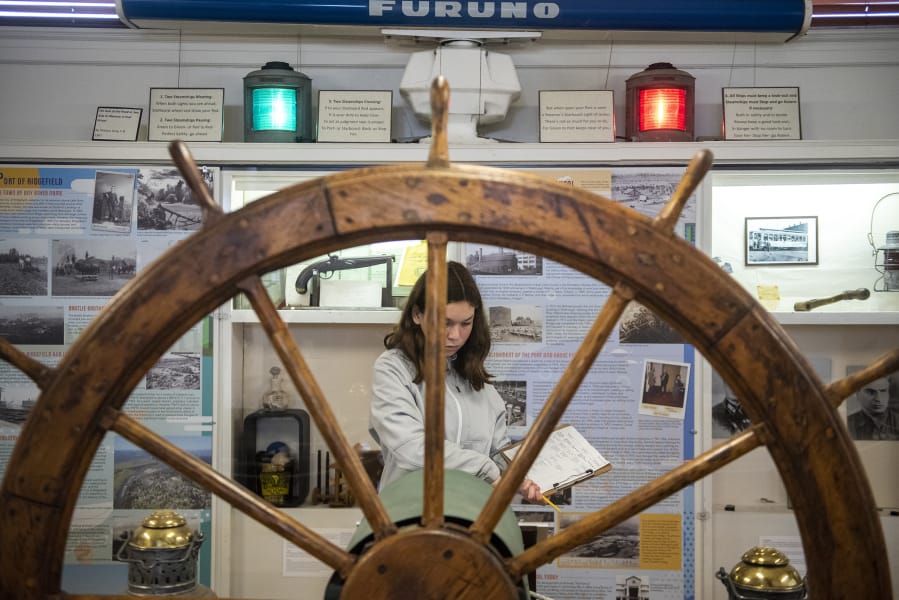Yesteryear’s children loved exploring the Clark County Historical Museum because they could get their big imaginations, if not their little mitts, on authentic artifacts like a 6-foot wheel from a real Columbia River ferry.
“People remember that giant wheel,” said Brad Richardson, the museum’s executive director. “Parents and grandparents have been bringing their children and grandchildren in here and they are so excited to rediscover that wheel and share it.”
You’re still not allowed to touch the wheel, which serves as the centerpiece of a rich new exhibit called “Currents of Progress: Clark County Rivers, Roads and Ports.” But there’s still plenty for kids and their families to do during a visit to this historical transportation showcase, from learning to tie nautical knots to triggering a red beacon while practicing Morse code.
An intricate language of dots and dashes may be tough for today’s speedy young texters to fathom, but museum officials say they’re making headway with exactly that kind of history lesson.
IF YOU GO
What: “Currents of Progress: Clark County Rivers, Roads and Ports.”
When: 11 a.m. to 4 p.m. Tuesdays through Saturdays.
Where: Clark County Historical Museum, 1511 Main St., Vancouver.
Admission: $5; $4 for seniors and students; $3 for children ages 6 through 18; free for children 5 and younger.
On the web:www.cchmuseum.org
“Many more kids are coming in here, and getting to know our history, because their parents and grandparents are bringing them,” Richardson said.
“There’s been a lot more focus on how children can interact with the displays,” said James Kice, the collections and operations manager. “Our hope is to make it really fun, and then sneak a little bit of education in too.”
As Kice put it while tapping out a Morse code S-O-S: “Who doesn’t like playing with flashing lights?”
(In a neighboring museum gallery, the interactive “Music, Movement and Sound” exhibit is still on display, complete with real bongos and other instruments to try. Who doesn’t like shredding on an electric guitar?)
Open secrets
Preparing “Rivers, Roads and Ports” sent Kice diving into the Clark County Historical Museum’s off-site, 10,000-square-foot storage facility — which is filled with so many precious objects, museum officials prefer not even to hint at its location, they said.
Kice said he spent plenty of time scanning lists and object descriptions, but also made some startling discoveries by prowling the corridors and opening boxes.
Ever heard of a pelorus? It’s a nautical directional tool that resembles a compass — but a pelorus includes no magnet and can’t tell you absolute directions, like which way north is. It only provides relative bearings. Sailors sometimes call it a “dumb compass.”
The pelorus in the “Currents of Progress” display was donated to the museum decades ago by a Portland yacht club member who did his own research and determined that this particular instrument used to sit on the bridge of a well-known steam yacht, the Aquilo, which operated in Puget Sound and beyond throughout much of the last century.
Across from there sits a special discovery that still surprises Kice. He had no idea, he said, that the collection includes a big bottle of Russian cologne autographed by the three pilots — Valery Chkalov and his two companions — who made an emergency landing at Pearson Field after their record-setting transpolar flight of 1937.
Any remaining hints of historical fragrance are off-limits to you because the bottle sits behind glass, but Kice said he enjoyed some exclusive sniffs.
“It had a sweet, light fragrance,” he said.
Eye levels
The exhibit was designed to keep visitors of different ages equally engaged, Richardson said. There’s plenty of detailed text for grown-ups who like to read, but also timelines, interactive opportunities and a few treats at lower eye levels.
Local ports and the Tidewater company all contributed information and artifacts, Richardson said, with the Port of Vancouver providing something kids will love: a Lego container ship. (“There were no Lego ship models when I was a kid,” Kice added wistfully.)
The exhibit strives to include others too. It highlights Minnie Hill, the first woman riverboat captain west of the Mississippi River. She learned the trade from her husband, Charles, and the couple worked together in the 1880s and 1890s to run their ship, the Gov. Newell, on the Lewis and Columbia rivers. (Charles was the engineer; his wife was the pilot and captain.)
And, the exhibit features a few fascinating artworks and tools that came from the indigenous “Lake River Ceramics Makers” who once occupied the Felida and Ridgefield areas — until they mysteriously vanished around 1600.
“(The pieces) are all so exquisitely detailed,” Kice said. “I only pulled a few, but this was an important connection to draw.”
“Some people know this history, but it’s fun to introduce it to people who don’t, yet,” Richardson said. “We are all river people, the entire county, because rivers shape our lives.”




